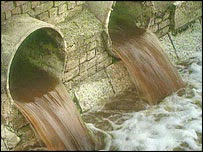CRIME: Detecting drug abuse through sewage.
 |
| Source: news.bbc.co.uk |
From a civil liberties viewpoint, this should be about as welcome as drone aircraft circling overhead. From a crime detection standpoint, it could quickly spot a meth cooking operation or other activity. For the author of crime fiction, it's one more twist to add to a plot.
Here's the story:
The war on drugs could get a boost with a new method that analyzes sewage to track levels of illicit drug use in local communities in real time. The new study, a first-of-its-kind in the U.S., was published in the ACS ournal Environmental Science & Technology and could help law enforcement identify new drug hot spots and monitor whether anti-drug measures are working.
Kurunthachalam Kannan and Bikram Subedi note that to date, most methods to estimate drug use in the U.S. are based on surveys, crime statistics and drug seizures by law enforcement. But much illegal drug use happens off the radar. To better approximate usage, scientists have been turning to wastewater. Like a lot of other compounds from pharmaceuticals and personal care products to pesticides, illegal drugs and their metabolic byproducts also persist in sewage.
 |
| Suggested reading click on image |
Surprisingly, the scientists found cocaine in 93 percent of all untreated samples. Levels of byproducts from opioids and hallucinogenic drugs were also detected. They found that the wastewater treatment plants didn't remove all illicit drugs before releasing water back into the environment -- and eventually into drinking water. But, the researchers suggest, tracking drugs in wastewater could help policymakers and law enforcement understand patterns of abuse and better fight it.
* * * * *
Story Source: Materials provided by American Chemical Society. Bikram Subedi, Kurunthachalam Kannan. Mass Loading and Removal of Select Illicit Drugs in Two Wastewater Treatment Plants in New York State and Estimation of Illicit Drug Usage in Communities through Wastewater Analysis. Environmental Science & Technology, 2014
Comments
Post a Comment